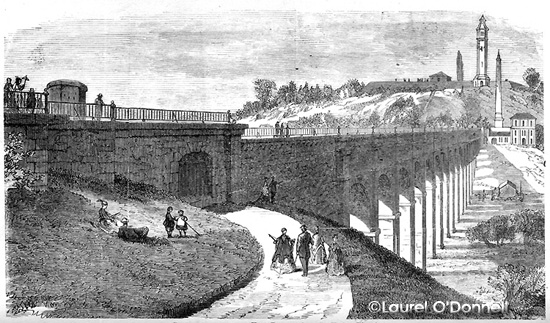|
|
Chapter IV
New York As It Is.
How New York is Supplied with Water A. Description of the Island.—
B. Population at Different Periods.—
C. Streets and Avenues.—
D. Architecture of Manhattan—
E. Business in New York—
F. Churches of New York—
G. Parks and Squares.—
H. How New York is Supplied with Water.—
I. The Schools and Colleges of New York.—
J. Public Security—
K. New York All the Year Round—
L. The Libraries, Monuments and Markets of New York—
M. The Cemeteries of New York.
 Croton Aqueduct and the High Bridge. (Over the Harlem River) BEFORE the introduction of the Croton, the inhabitants of Manhattan suffered perpetual perils from fires, drought, and the impurities of their daily beverage. A liberal supply of pure water is one of the first conditions of health and happiness, with any people; but how to thus supply a vast city has been a question that has agitated the Solomons, the Caesars, and the Montezumas. For many years the inhabitants of Manhattan depended upon public and private wells. In 1659, there were eleven public wells in the little city—two in Wall street, three in Broadway, four in Broad street, and two on the East riverside. These were used for watering horses and extinguishing fires, the families mainly depending upon private wells in their own yards. As the city enlarged, the demand for water increased; various schemes were discussed and experiments vainly tried, during half a century, until a board of Commissioners finally took the matter resolutely in hand, and after eight years of study and toil, completed in 1842 the most extensive and magnificent enterprise of the kind in modern times. A dam thrown across Croton river raised the water forty feet, forming Croton lake. The aqueduct proper is constructed of stone, brick, and cement, arched above and below, is seven and a half feet wide, and eight and a half high, with an inclination of thirteen inches to the mile; the flow of water for some years was about twenty-seven million gallons daily, but at present reaches nearly sixty millions, its full capacity. In Westchester county it crosses twenty-five streams, averaging from twelve to seventy feet below the line of grade, besides numerous brooks furnished with culverts. The water is carried across Harlem river in vast iron pipes on a bridge of granite, 1450 feet long, which is supported by fifteen arches, the crown of the highest being 100 feet above high-water mark, to prevent interference With navigation. Two deep valleys are ingeniously crossed, between this river and the receiving reservoir opposite Eighty-sixth street, which covers thirty-five acres, and contains 150,000,000 gallons. Several years since a retaining reservoir was added, covering over 100 acres, and thirty-eight feet deep, capable of holding one billion and thirty million gallons. Two large reservoirs have just been constructed—the "Storage reservoir," and the ,"High Service," at Carmansville. From the receiving to the distributing reservoir, a distance of two and one-fourth miles, the water is conducted through several lines of iron pipe three or four feet in diameter.
|
|
97
:: Previous Page :: Next Page ::
Books & articles appearing here are modified adaptations
from a private collection of vintage books & magazines. Reproduction of these pages is prohibited without written permission. © Laurel O’Donnell, 1996-2006.
|
|

